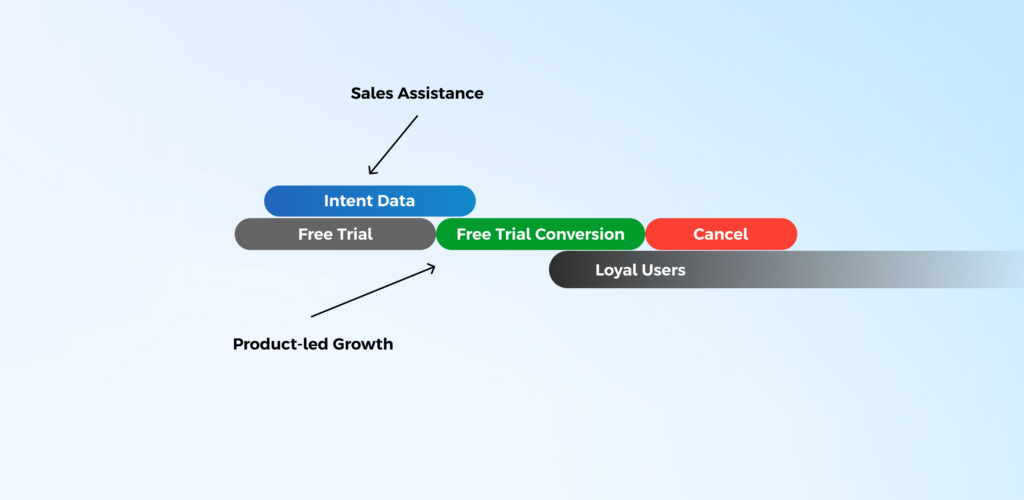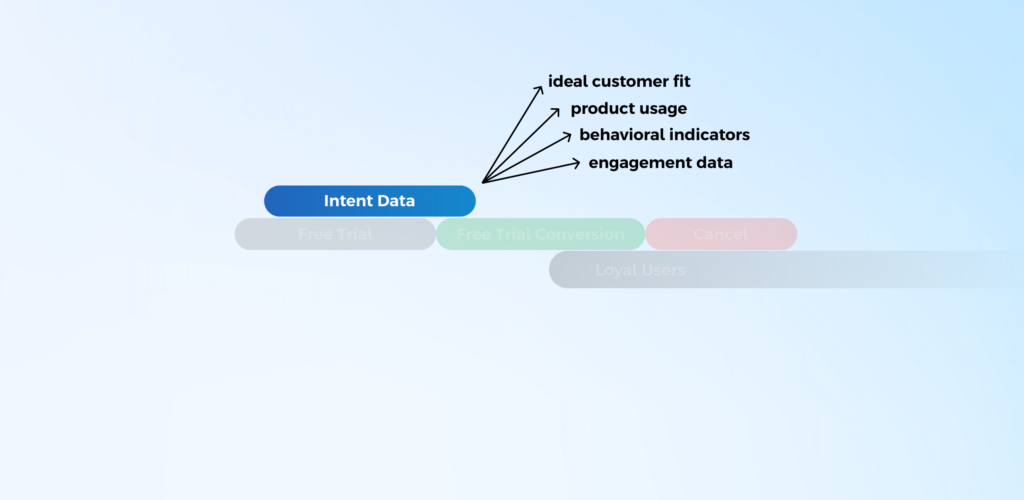Everyone in SaaS who has adopted a product-led growth or self-service strategies with free trials has one common goal: converting those free trials into paid customers.
There is a certain magic in free usage; it allows users to explore your product without the need for a demo or salesperson. However, this magic has its limits.
Unlike demo or sales interactions, it can be more difficult to distinguish interest from disinterest in a free trial setting.
Here we will explore the most effective methods to distinguish interest from disinterest and double your free trial conversion.
What is free trial conversion in SaaS environment?
Free trial conversion is one of the popular conversions among SaaS businesses. It refers to the transition of a user with free capabilities for a period to a customer who decided that the product is worth paying for.
SaaS products highly depend on free trials with limits on time periods, usage, or seats. This is a simple strategy for showing the value of the product at some level and pushing users to the paid plans.
We touched different points of it in our free trial conversion rate article, check it out.
Free trial conversion in product-led growth
For businesses with a product-led growth strategy, free trial conversion is an important metric. Free trials, though not the entire PLG, play an important role in showing the value of the product and turning users into paying customers.

The focus of the PLG approach is to create self-service experiences. The product is designed to effectively market, sell and support itself. Users can independently sign up, explore and realise the value of the product without heavy sales efforts. This self-sufficiency is the cornerstone of PLG.
Monitoring free trial conversion rates provides valuable insights for improvement. These insights go beyond sales tactics and analyse the product itself. Low conversion rates may indicate that users fail to see the value of the product or face barriers to fully experiencing its benefits.
Analysing conversion rates helps businesses identify areas for improvement, such as improving onboarding, adding engaging features or enhancing customer support.
In a PLG model, a smooth upgrade path from free trial to paid plans is essential. The transition should be smooth and straightforward. This ensures that users understand the additional value they will receive as paying customers.
By focussing on these aspects, businesses can achieve higher conversion rates, increase user satisfaction and drive sustainable growth.
What is the role of intent data in this process?
Unlike demo or sales interactions, distinguishing interest from disinterest in a free trial can be challenging.
Intent data takes on the role of differentiating users with genuine intent from the rest of the trial users.
By analyzing user behaviors and engagement patterns, intent data helps identify those who are truly interested in the product amidst the plethora of data generated by free trial users. This precise identification allows businesses to focus their efforts on high-intent users, optimizing their conversion strategies and ensuring that resources are directed towards those most likely to convert into paying customers.
- Intent data provides an understanding of user behaviors and the level of intention a user shows to convert during the free trial.
- For businesses relying on any type of free trials, these insights become their competitive edge.
- By looking at these insights, businesses can prioritize their efforts on high-intent users, ensuring resources are used efficiently and effectively.
- Intent data allows businesses to customize their messaging and product offerings based on user behavior.
Example: If data shows that users frequently engage with a specific feature, businesses can highlight advanced functionalities of that feature in their communications, demonstrating its value and encouraging users to upgrade to a paid plan.
- Additionally, intent data helps businesses recognize friction points within the user journey.
Example: If many users abandon the trial after the initial setup, it may indicate a complex onboarding process. By identifying and addressing these issues, such as by simplifying the setup or providing more guided tutorials, businesses can improve the overall user experience and reduce drop-offs.
Why intent data is important for free trial conversions?
Intent data is important for free trial conversions because it provides actionable insights that can significantly enhance the conversion process. By understanding user behaviors and engagement levels, businesses can tailor their strategies to effectively convert trial users into paying customers.

Behavioral indicators
Behavioral indicators are specific actions or patterns of behavior that signal a user’s intent and likelihood to convert. These indicators can include frequent logins, repeated use of specific features, time spent on the platform, and interactions with advanced functionalities. By monitoring these behaviors, businesses can identify users who show strong interest and engagement.
Engagement metrics
Engagement metrics provide a quantitative measure of how users interact with a product during their free trial. Key metrics include the number of sessions, duration of each session, feature usage frequency, and response to in-app messaging. High engagement levels often correlate with higher conversion potential, as they indicate a deeper investment in the product.
How to increase free trial conversions with intent data?
1. Identify high-intent users
Intent data helps identify users who exhibit behaviors that indicate a strong likelihood of conversion. By analyzing actions such as frequent logins, high feature usage and engagement with premium functionalities, you can identify users with high intent.

Focusing your marketing and sales efforts on these potential customers increases the chances of conversion as these users have already shown significant interest in your product.
2. Personalize user onboarding
Use intent data to customize the onboarding experience based on individual user behavior and preferences. For example, if a user shows interest in certain features during a trial, tailor the onboarding process to highlight these features.
Personalized onboarding helps users quickly understand the value of the product, increasing the likelihood of conversion. This approach makes users feel valued and supported from the start, increasing their overall satisfaction and loyalty.
3. Start targeted communications
Analyze intent data to send timely and relevant messages to users based on their actions and level of engagement. For example, if a user frequently uses a certain feature, send tips and best practices related to that feature.
Also, remind users of the benefits of upgrading to a paid plan and offer special incentives to encourage conversion. Personalized communications ensure that users receive information that is directly relevant to their needs and interests.
4. Optimize in-app messaging
Implement in-app messages that respond to user behavior in real time. For example, if a user seems stuck on a particular feature, provide helpful hints or direct them to relevant support resources. These contextual nudges can enhance the user experience and guide users to get the most out of the trial. Real-time in-app messaging can address user questions and concerns immediately, reducing frustration and increasing the likelihood of conversion
5. Analyze drop-off points
Use intent data to identify where users drop out or churn during the trial period. Analyzing these points can help you understand common barriers to conversion.
For example, if users often give up after the initial setup, consider offering different onboarding tutorials. Reducing friction points can lead to a smoother user experience and higher conversion rates.
6. Enhance feature visibility
Identify which features drive the most engagement and highlight them prominently in your product and communications. Use intent data to identify which features are most popular with trial users and make them easily accessible.
Demonstrating the value of key features can encourage users to upgrade from free trials to paid plans. For example, if data shows that collaboration features are widely used, highlight them in your marketing materials and onboarding process.
Improve free trial conversion with UserMotion’s intent signals
UserMotion delivers intent signals that can powerfully increase your ability to improve your ability to convert free trial users into paying customers.
UserMotion provides detailed insights into user engagement, preferences and potential barriers to conversion by combining analytics and user behavior tracking.
1. High-potential conversions
With UserMotion’s intent signals, you can easily identify users with a strong likelihood of conversion.

It analyzes company characteristics, ideal customer profile fit, activity, feature usages, milestone events and engagements.
Focusing your efforts on these potential customers increases the chances of conversion, as they have already shown significant interest in your product.
2. Onboarding customization
UserMotion’s detailed user insights allow you to customize the onboarding experience based on users.
If a user shows interest in certain features during the trial, you can customize the onboarding process to highlight these features.
Personalized onboarding helps users quickly understand the value of the product.
3. Meaningful communications
UserMotion’s intent signals helps you send timely and relevant messages to users based on their actions and engagement levels.
You can remind users of the benefits of upgrading to a paid plan to encourage conversion. Personalized communications ensure that users receive information directly relevant to their needs and interests.
4. In-app messages optimization
Use UserMotion’s insights to implement in-app messages that respond to user behavior in real time. For example, if a user seems stuck on a particular feature, provide helpful hints or direct them to relevant support resources.
These contextual triggers enhance the user experience and guide users to get the most out of the trial. Real-time in-app messaging can address user concerns immediately and reduce frustrations.
5. Prevent churn in trial period
UserMotion helps you identify where users drop off or churn during the trial period. By analyzing these points, you can understand common barriers to conversion and make necessary adjustments.

For example, if users frequently abandon the trial after the initial setup, consider introducing more simple or short onboarding tutorials.
6. Highlight popular usage patterns and features
Use UserMotion’s data to identify which features or patterns drive the most engagement and highlight them prominently in your product and communications.
If certain features are particularly popular among trial users, make them easily accessible and showcase their value.
For instance, if collaboration features are widely used, emphasize these in your marketing materials and onboarding process.
Key Takes
- Converting free trials into paid customers is a common goal in SaaS with product-led growth.
- Free trial conversion is transitioning a user from a free trial to a paid customer.
- Free usage allows exploration without demos or salespeople, but has limitations.
- Distinguishing interest in free trials can be challenging without direct interaction.
- Intent data helps differentiate interested users from others during free trials.
- Intent data analysis allows businesses to focus on high-intent users for better conversion.
- Customizing messaging and onboarding based on user behavior enhances conversion rates.
- Identifying and addressing friction points in the user journey can reduce drop-offs.
- Behavioral indicators and engagement metrics are key in identifying high-intent users.
- Personalized onboarding and targeted communications improve user satisfaction and conversion.
- Real-time in-app messaging can address user issues immediately, reducing frustration.
- Tools like UserMotion provide detailed insights and intent signals to enhance free trial conversion efforts.






